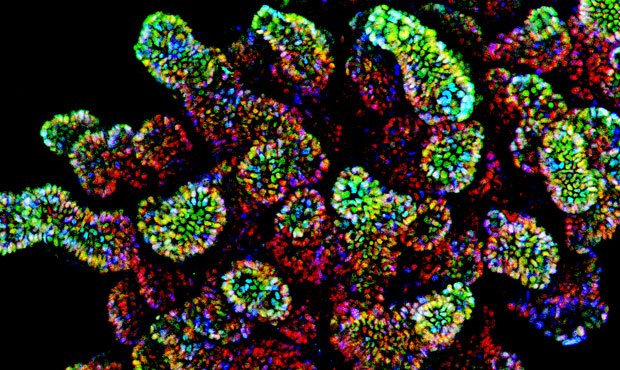Introduction
Researchers at Weill Cornell Medical College have developed a new approach to studying colon cancer using induced pluripotent stem cells. Induced pluripotent stem cells are functionally similar to embryonic stem cells, however rather than being isolated from discarded embryos, they can be derived from adult skin and white blood cells, avoiding any ethical controversies. These cells have the ability to grow into any tissue type, and have been used to study diseases of the skin, heart, bone marrow, lungs, and nervous system. In a paper published in Nature Medicine, Crespo et al. describe their methods for generating 3-dimensional organoid structures comprised of large intestinal cells and the implications this method has on colon cancer research.

Summary of Study
In order to create human colonic organoids, the authors relied previous discoveries about mouse embryonic development and the signaling pathways which control the development of the large intestine. Although the studies had been performed in mice, the information was used as road map for creating human large intestinal cells. The researches used small molecules to activate and inhibit different signaling pathways in the cells, activating specific genes which direct the stem cells into colonic tissue.
Once the cells had transitioned into colonic cells, they were split into individual cells and placed in a small sphere of material called Matrigel - a biologic secretion from mouse tumors which supports cell growth. The individual cells then began to divide, and eventually organized into 3D structures with a tissue architecture resembling that found in the colon. The scientists verified the tissue was indeed colonic by confirming the expression of genes and proteins which are only active in the colon.
Impact and Conclusions
Scientists have previously generated colonic organoids from surgically removed sections of colon from patients. This is the first study to perform this feat using only stem cells. For people with a family history of colon cancer, this study may pave the way toward understanding how cancer begins in the large intestine by using tissues grown from their own genetic material, without having to undergo invasive surgery. Once stem cells have been created from an individual, they can be grown indefinitely and used to generate tissues in perpetuity. In addition to studying how cancer begins, scientists can also use this 3D organoid platform to study new ways to treat cancer. Rather than beginning with animal studies, researchers can use real human tissues to test new and currently-approved drugs on both cancerous and normal tissues, opening the door to personalized medicine.
Reference
Crespo, M., Vilar, E., Tsai, S., Chang, K., Amin, S., Srinivasan, T., Zhang, T., Pipalia, N.H., Chen, H. J., Witherspoon, M., Gordillo, M., Xiang, J. Z., Maxfield, F. R., Lipkin, S., Evans, T., Chen, S. Colonic organoids derived from human induced pluripotent stem cells for modeling colorectal cancer and drug testing. Nature Medicine. 2017. Epub ahead of print. doi: 10.1038/mm/4355